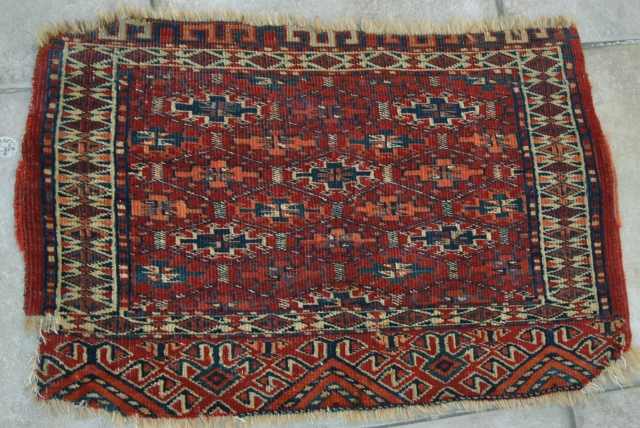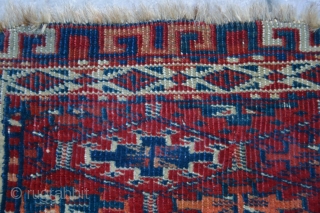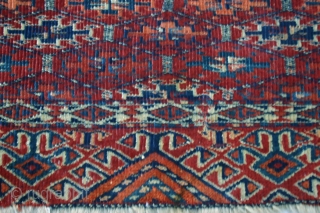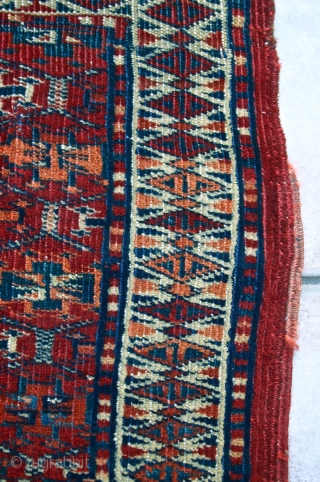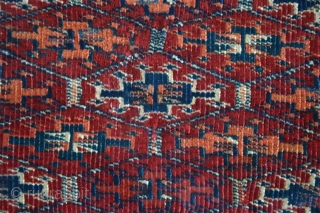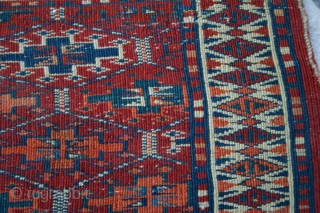Back
This is a rather rare 19th c. Turkmen Khordjin. sw Turkmenistan. a guess seems to be one of these Yomud (Goklen?), subtribes living in the SouthWest and in literature known as Djafarbay and Atabay. it is all within the weaving pool of the South-West, Gurgan and Atrek plains and Akhal Oasis all near to the Persian border and Persian influence over very long and changeful periods. Many tribes have mixed in this area.
The weaving is extremely fine with un-beached white wool warps of a high quality, and very fine white cotton and brownish-red wefts in separate sections, (not mixed). As is indicated in the photos, it is a asymmetric knot, open to the right. It has a slightly ribbed effect on the back. The weaving is more similar in quality to a mid century Merv Tekke piece, tho it is most certainly not a Tekke. i date it to circa 1870-80, as the quality of the colors, materials, and weave are all of a very high standard. There are no Bad Colors; in fact all the dyes are excellent, including the rose color!
Most Turkmenophiles date almost any Khordjin to the late 19th c., as there are so few examples, and indeed most are late; but certainly the earlier tribes were more likely to be on horseback then the later ones, and why would they not have woven khordjin.... especially those intermingling with Persian tribes, almost all of whom wove pile khordjin?
The pile is decent, tho it has also a "ribbed" effect on the front because of the tight asymmetric knotting and lowness of the pile. The piece has been completely stabilized on all sides and where there were small breaks in the cotton wefting (about five or six small 1 to 2 cm slits), it has been pulled together and sewn with a very fine thread. After the wash the wefts are no longer breaking.
Size: 35 cm. x 55 cm.
- Home
- Antique Rugs by Region
- Category
- Profiles
- Post Items Free
- Albums
- Benaki Museum of Islamic Art
- Budapest: Ottoman Carpets
- Gulbenkian Museum
- Islamic Carpets. Brooklyn
- Islamic Textiles. Brooklyn
- Konya Museum: Rugs
- MKG, Hamburg
- MMA: Caucasian Carpets
- MMA: Mamluk Carpets
- MMA: Mughal Indian Carpets
- MMA: Ottoman Carpets
- MMA: Safavid Persian Carpets
- MMA: Turkmen Rugs
- McCoy Jones Kilims
- Ottoman textiles. Met
- Philadelphia Museum
- Rugs and Carpets: Berlin
- Seljuqs at the Met
- TIEM, Istanbul: Carpets
- V&A: Classical Carpets
- Vakiflar Carpets: Istanbul
- Baluch Rugs: Indianapolis
- Gallery Exhibitions
- Jaf an Exhibition
- Alberto Levi Gallery
- Andean Textile
- Christie's London: 2016
- Francesca Galloway
- HALI at 40
- ICOC Washington, DC 2018
- Jajims of the Shahsavan
- London Islamic Week April, 2018
- Mongolian Felts
- Navajo Rugs: JB Moore
- Persian Piled Weavings
- SF Tribal & Textile Art Show 2020
- SF Tribal 2019
- Sotheby's: C. Alexander
- Turkish Prayer Rugs
- Turkmen Main Carpets ICOC 2007









